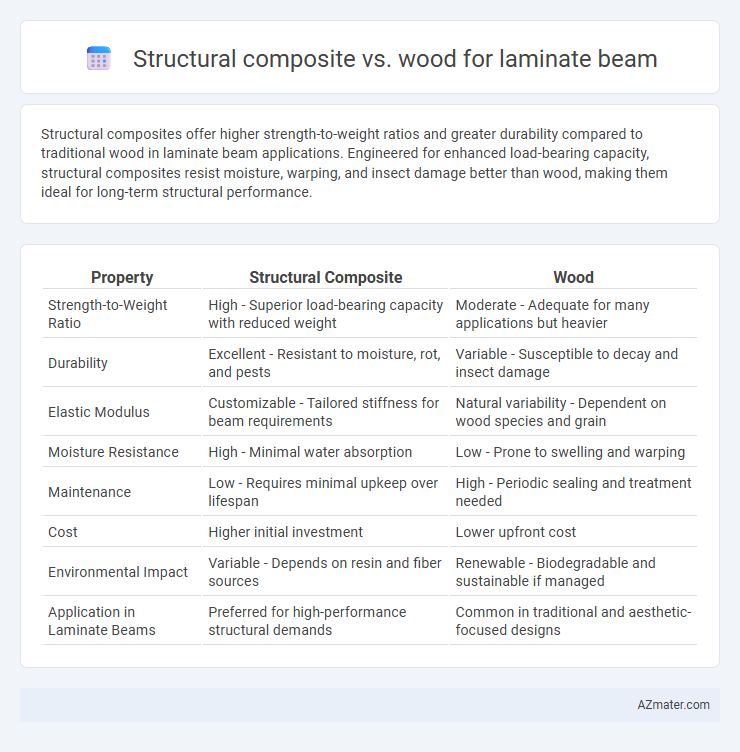Structural composites offer higher strength-to-weight ratios and greater durability compared to traditional wood in laminate beam applications. Engineered for enhanced load-bearing capacity, structural composites resist moisture, warping, and insect damage better than wood, making them ideal for long-term structural performance.
Table of Comparison
| Property | Structural Composite | Wood |
|---|---|---|
| Strength-to-Weight Ratio | High - Superior load-bearing capacity with reduced weight | Moderate - Adequate for many applications but heavier |
| Durability | Excellent - Resistant to moisture, rot, and pests | Variable - Susceptible to decay and insect damage |
| Elastic Modulus | Customizable - Tailored stiffness for beam requirements | Natural variability - Dependent on wood species and grain |
| Moisture Resistance | High - Minimal water absorption | Low - Prone to swelling and warping |
| Maintenance | Low - Requires minimal upkeep over lifespan | High - Periodic sealing and treatment needed |
| Cost | Higher initial investment | Lower upfront cost |
| Environmental Impact | Variable - Depends on resin and fiber sources | Renewable - Biodegradable and sustainable if managed |
| Application in Laminate Beams | Preferred for high-performance structural demands | Common in traditional and aesthetic-focused designs |
Overview: Structural Composite vs Wood in Laminate Beams
Structural composites used in laminate beams offer superior strength-to-weight ratios and enhanced durability compared to traditional wood materials, making them ideal for high-performance applications. Wood, while more cost-effective and sustainable, can be susceptible to moisture, decay, and dimensional instability, which limits its long-term structural reliability in laminate beam construction. Advances in engineered composites allow for precise control over mechanical properties, optimizing load distribution and resistance to environmental stressors beyond the capabilities of natural wood.
Material Composition and Manufacturing
Structural composite beams are typically made from layers of fiber-reinforced polymers bonded with resins, offering superior strength-to-weight ratios and resistance to environmental factors compared to traditional wood. Wood laminate beams consist of glued layers of timber, such as laminated veneer lumber (LVL), which provide natural elasticity and cost-effectiveness but can be susceptible to moisture and biological decay. Manufacturing composites involves advanced processes like resin infusion and curing under controlled conditions, while wood laminates rely on precision drying, adhesive application, and pressing techniques to ensure structural integrity.
Strength and Load-Bearing Capacity
Structural composite materials exhibit higher strength-to-weight ratios compared to traditional wood, making them ideal for laminate beams requiring superior load-bearing capacity. Engineered composites resist warping, splitting, and environmental degradation, enhancing durability and maintaining structural integrity under heavy loads. Wood laminate beams provide natural rigidity but typically offer lower tensile strength and are more susceptible to moisture-induced weaknesses than advanced composite alternatives.
Durability and Resistance to Environmental Factors
Structural composites for laminate beams offer superior durability and enhanced resistance to environmental factors compared to traditional wood. Composite materials such as fiberglass or carbon fiber reinforced polymers exhibit high resistance to moisture, rot, insects, and UV degradation, significantly extending the lifespan of laminate beams in harsh conditions. Wood laminate beams, while cost-effective and sustainable, require protective treatments and regular maintenance to mitigate vulnerability to warping, decay, and fungal attacks in outdoor or humid environments.
Weight and Flexibility Comparisons
Structural composite laminate beams typically offer a superior strength-to-weight ratio compared to wood, making them significantly lighter while maintaining high load-bearing capacity. Composites provide enhanced flexibility and resistance to bending without permanent deformation, unlike wood, which can be more prone to cracking or warping under stress. The controlled layering and fiber orientation in structural composites allow precise tuning of stiffness and flexibility, outperforming the natural variability found in wood laminates.
Cost Analysis: Initial and Long-Term Investments
Structural composites typically have higher initial costs than wood due to advanced manufacturing and material expenses. Over time, composites offer reduced maintenance and longer service life, resulting in lower long-term costs compared to wood's susceptibility to rot, warping, and frequent repairs. Lifecycle cost analysis often favors composites when considering durability, performance consistency, and reduced replacement frequency in laminate beam applications.
Sustainability and Environmental Impact
Structural composite materials for laminate beams outperform traditional wood in sustainability by utilizing recycled fibers and resins, reducing deforestation and carbon footprint. Wood laminate beams, while renewable and biodegradable, face challenges like habitat loss and slower regrowth rates impacting environmental balance. Advanced composites also offer longer service life and lower maintenance emissions, enhancing overall ecological benefits compared to natural wood alternatives.
Installation and Workability Differences
Structural composite laminate beams offer superior workability with lighter weight and uniform material properties, enabling easier handling and faster installation compared to traditional wood beams. Wood beams require more skill for precise cutting and fitting due to natural variability and susceptibility to warping or splitting, potentially extending installation time. The engineered nature of structural composites reduces on-site adjustments, improving overall efficiency in beam installation projects.
Maintenance and Lifespan Evaluation
Structural composite laminate beams exhibit superior resistance to moisture, rot, and insect damage compared to traditional wood, resulting in significantly lower maintenance requirements over time. The lifespan evaluation of composite beams typically surpasses that of wood, often exceeding 50 years under standard environmental conditions due to enhanced durability and stability. Wood laminate beams, although initially cost-effective, demand regular treatment and inspection to prevent deterioration, leading to higher long-term maintenance costs and reduced service life.
Best Applications for Structural Composite and Wood Laminated Beams
Structural composite beams excel in applications requiring high strength-to-weight ratios, such as long-span bridges and architectural elements exposed to variable environmental conditions, due to their superior durability and resistance to moisture and corrosion. Wood laminated beams are ideal for residential construction and interior frameworks where aesthetic appeal, ease of customization, and sustainability are prioritized, offering excellent thermal insulation and natural resilience. Both materials benefit from engineered lamination processes, but structural composites outperform in outdoor and industrial settings, while wood laminates remain preferred for traditional construction and eco-friendly designs.

Infographic: Structural composite vs Wood for Laminate beam
 azmater.com
azmater.com